1 Watt LED
ONE WATT LED Pin Configuration
1 WATT LED (Light Emitting Diode) like any other LED has two terminals. One is POSITIVE TERMINAL and another is NEGATIVE TERMINAL.
|
Pin Number |
Pin Name |
Description |
|
1 |
Anode (Positive) |
This pin is connected to Positive of power source. |
|
2 |
Cathode(Negative) |
This pin is connected to Negative of power source. |
Features
- Very long operating life (up to 100k hours)
- Available in Red, Yellow, Green, Blue, White
- Low voltage DC operated
- NO ULTRAVOILET radiation
- RoHS compliant — Lead-free
- Suitable for PWM, fully dimmable
- Superior ESD protection
- LAMBERTIAN radiation pattern
Electrical Characteristics
- Voltage applied between ANODE and CATHODE : 3.0 V to 3.5 V (Typical Operating Voltage : 3.3 V)
- Current through LED (Light Emitting Diode): 300mA to 350mA(350mA being absolute maximum forward current allowed through LED)
- Maximum reverse voltage between ANODE and CATHODE: 5 V
- Maximum Power dissipation: 1Watt
- Operating temperature: - 40 ºC to +80 ºC
- Operating LIFE : 100000 hours
Note: Complete technical information can be found in the 1 Watt LED Datasheet linked at the bottom of this page.
Equivalents
One Watt LED is like choosing a resistor. The Wattage of LED will be same no matter the manufacturing industry. The difference occurs in Temperature handling and Luminous Intensity output. Choosing the LED with Industrial standards is always better.
Why We Use 1 Watt LED
For better understanding the uses of ONE WATT LED consider few cases:
Case1: For better LUMINOUS OUTPUT. If one considered a 5mm LED, the Light Intensity provided by it considered good. But it is not up to standards of conventional Lighting. Stacking them up will be troublesome. So using the ONE WATT LED is versatile in those cases as the output by it is considerable high.
Case2: For better power handling. The ONE WATT LED has HEAT SINK mounting facility. With this convenience, the LED can easily dissipate the heat and can handle one Watt power. Normal 5mm LED cannot mount on HEAKSINK and will burn out if slightly overpowered.
Case3: For power saving. The LUMINOUS OUTPUT per WATT provided by LED is higher when compared to conventional LIGHTING SYSTEMS like INCANDESCENT BULB. So over time the power will be saved when using LIGHTING SYSTEMS manufactured by using ONE WATT LED.
Case4: For longer life. The LIGHTING SYSTEMS made by using ONE WATT LED will have more life when compared to the conventional ones.
Case5: For Health. The ONE WATT LED does not generate UV rays which can be said another advantage.
How to Use 1 Watt LED
ONE WATT LED can be used as easily as any other LED. All you need to connect a 3.3 V power source across it.
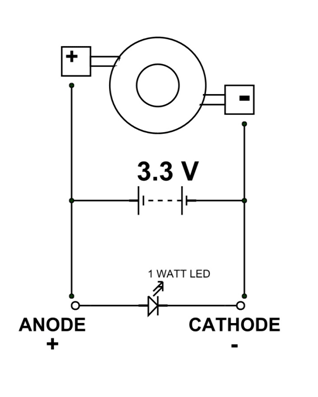
As shown in the 1 Watt LED circuit diagram, if you have a 3.3 V standard voltage source you can direly connect it to LED for making it work.
In case you don’t have a 3.3 V standard power source, you can take higher voltages and add series resistor.
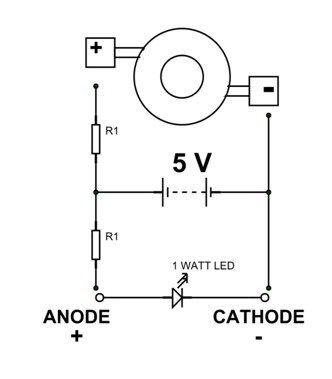
Here,
Current through LED = 0.3 Amp.
Voltage across LED = 3.3 Volt.
Voltage across resistor R1 = 5 - 3.3 = 1.7V
Resistor R1 = 1.7/0.3 = 5.7Ω.
Like this, for different voltages we can calculate the series resistance required current limiting.
This will work for normal situations but for operating the LED with maximum efficiency and maximum potential, one need to considered many parameters. First let’s see the relationship between Voltage and Current for the LED.
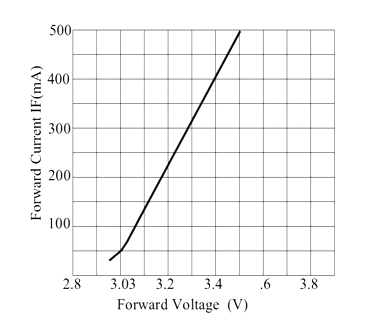
As shown in figure after the supply voltage crosses 3.0V there will be sharp increase in forward current. With every 0.1V increase the forward current increase is very high.
Now consider the Current and Luminous output relationship of LED:
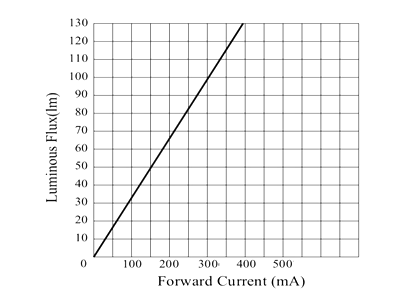
As you can see in graph, the LED output increases linearly with forward current. So for making the LED work at maximum potential we need to maintain the forward current at standard value. For doing it we need to provide the CONSTANT CURRENT SOURCE or feedback system for the LED. So with CCS we can make LED work at maximum potential.
Applications
- Portable flashlight.
- Reading lights (bus, aircraft).
- Stair and Cabinet lighting.
- Decorative purposes.
- Exit and Enter signs.
- Automobile tail lights
- Fiber optics
2D-Model and Datasheet
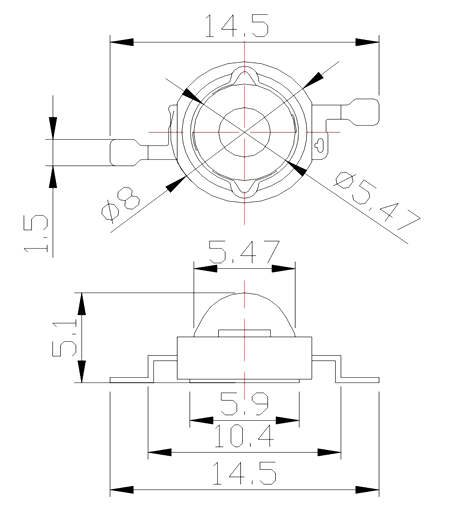
All dimensions are in millimeter.











